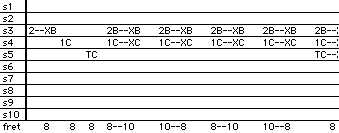 |
|||
 |
|||
Tablature |
||||||
|
To take a look inside tablature, I'm going to use two types and compare them. The first type is traditional tab and the second type is what I call right-hand tab. The right-hand tab is based around the right hand and the actions that take place when you play a lick. As you get more proficient at reading tablature, you should be able to sight-read it at a comfortable pace. The key is spending time at your guitar and learning to see the movements on the page and translate them into hand and foot movements. The most important thing we can do is to pick the strings. Thats why I developed Right Hand Tab. The right hand must be able to make the moves before you can play those licks that you are hearing. You can know all the music in the world but if your hands don't know it then you can't play it. Lets look at our first set of tab: |
||||||
|
||||||
|
Notice how traditional tab gives you the strings to pick, fret number and which pedals and knee lever to push, all within the string lines. It lacks detail on how to actually execute the move you need to make. With Right Hand Tab you notice that the left hand fret moves are below on a line by themselves. This allows me to show you which fingers to use to actually set the strings in motion. The T is the Thumb, 1 is the first finger, & 2 is the second finger. That allows me more detail in how I want you to make the lick happen. |
||||||
|
Here are some more tab examples. |
||||||
|
||||||
 |
The first move we make on this lick is the backward roll. The backward roll has a pedal mave added after the second finger picks. I use my first and second finger together a lot. Great alternates. |
